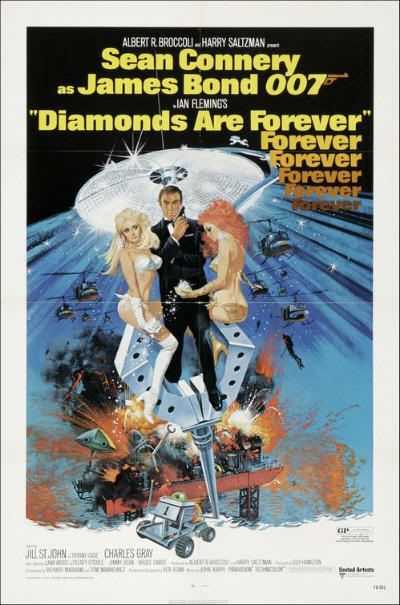 Diamonds are Forever begins with a faceless figure beating the crap out of a couple different guys over a couple quick scenes – all he wants to know is how to find Blofeld. In the third scene of the sequence, the figure’s face is revealed to be that of Sean Connery, and he isn’t much nicer to the babe at the pool than the other guys. Diamonds follows On Her Majesty’s Secret Service, which ended with the murder of Bond’s (George Lazenby) new bride Tracy (Diana Rigg) at the hands of Blofeld (Telly Savalas).
Diamonds are Forever begins with a faceless figure beating the crap out of a couple different guys over a couple quick scenes – all he wants to know is how to find Blofeld. In the third scene of the sequence, the figure’s face is revealed to be that of Sean Connery, and he isn’t much nicer to the babe at the pool than the other guys. Diamonds follows On Her Majesty’s Secret Service, which ended with the murder of Bond’s (George Lazenby) new bride Tracy (Diana Rigg) at the hands of Blofeld (Telly Savalas).Clearly this was a defining moment in Bond’s life, but with Diamonds the lead role shifted back to Connery, and in doing so the producers seem unsure about how to address the tragedy. The pre-credits sequence seemingly straddles the fence: The upfront, violent inquisitions are for the viewer who wants to pick up where the last film left off -- Bond is on a rampage and wants revenge…and yet Tracy is never mentioned. The viewer who’d rather forget the previous events (or is simply not privy to them) is free to do so: Maybe James is just tired of Blofeld’s shenanigans and wants to put an end to the cat and mouse nonsense?
Which he seemingly does -- by dumping Blofeld (now played by Charles “No Neck” Gray) into a pit of lavalike mud. Then the cat meows and we hear Shirley Bassey for the first time since Goldfinger…
Diamonds are forever,
Sparkling round my little finger.
Unlike men, the diamonds linger.
Men are mere mortals who
Are not worth going to your grave for.
I’ve got a huge soft spot (somewhere between my legs) for Diamonds are Forever. It’s the first Bond flick I ever saw, and that network airing left a big impression on the 9 or 10-year old me[1]. Despite being blissfully unaware it was part of a larger picture, afterwards I somehow didn’t miss any future airings of Bond flicks.
Les Girls: Once again, the central Bond babe knocks it out of the park. Jill St. John’s Tiffany Case
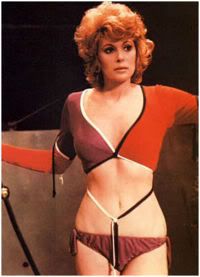 is a highlight of the proceedings. As is the case (ahem…) with the rest of the film’s components, Tiffany’s part is greater than the whole. As the first American Bond girl, she trumps many a U.S.-based successor by believably taking care of herself, whilst at the same time not really being the sharpest crayon in the box. Tiffany is something of a survivor, due in no small part to her sizzling sex appeal and easy-going demeanor, and given the body count in Diamonds, that’s noteworthy. Allow me some bluntness: Miss Case may well be the most bangable Bond girl of them all, which is no trivial honor.
is a highlight of the proceedings. As is the case (ahem…) with the rest of the film’s components, Tiffany’s part is greater than the whole. As the first American Bond girl, she trumps many a U.S.-based successor by believably taking care of herself, whilst at the same time not really being the sharpest crayon in the box. Tiffany is something of a survivor, due in no small part to her sizzling sex appeal and easy-going demeanor, and given the body count in Diamonds, that’s noteworthy. Allow me some bluntness: Miss Case may well be the most bangable Bond girl of them all, which is no trivial honor.Bond first meets Tiffany in her apartment where she gives him this funny little (completely gratuitous) fashion show, sporting various wigs and negligees. Her hair color & style change each time she exits and reenters the room:
Bond: “Weren’t you a blonde when I came in?”
Tiffany: “Could be.”
Bond: “I tend to notice little things like that – whether a girl’s a blonde or a brunette.”
Tiffany: “And which do you prefer?”
Bond: “Oh, providing the collars and cuffs match…”
A bit later there’s this priceless reaction:
Bond: “That’s quite a nice little nothing you’re almost wearing. I approve.”
Even James seems mildly taken aback by her audacity. If Diana Rigg’s Tracy was the culmination of the ‘60s girls, then Tiffany is a sound jumping-off point for the girls of the ‘70s. In the hands of a lesser actress, Tiffany probably wouldn’t come off nearly as sparkling as she does. For all of John’s assuredness and appeal, how she really sells Case is with her easy-going sense of humor. She really gets Bond, and seems to understand the fly-by-night nature of his being: Tiffany’s having fun for as long as the fun might last.
Also skimping about in various states of bimbocity is Lana Wood’s Plenty O’Toole – great character name and nice to look at, but not much else. And who can forget the combo of Bambi and Thumper, the sexy pair of guards James tussles with outside of billionaire Willard Whyte’s (Jimmy Dean) “prison”? Last but not least, there’s Mrs. Whistler (Margaret Lacey) -- possibly the oldest Bond girl in the series -- a sweet old lady masquerading as a teacher who’s really part of the diamond smuggling ring. She, like Plenty before her, ends up sleeping with the fishes. (OK, maybe she doesn't count, but I couldn't resist mentioning the woman who was probably Whistler's mother.)
Zee Henchmen: And who’s in charge of executing nearly every noteworthy (i.e. creative) death? Mr. Wint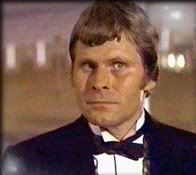 (Bruce Glover, father of all that is Crispin) and Mr. Kidd (Putter Smith, a jazz bassist with no prior acting experience). Some say that Wint & Kidd are an ambiguously gay duo -- I say they’re watching the movie with their eyes closed. There’s no way that Wint & Kidd are anything but heaping tablespoonfuls of Queer as Folk. Dare I mix some hackneyed Seinfeld standbys? “Not that there’s anything blah, blah, blah.” Props must be given to whomever’s idea it was for these guys to have a gay old time; this wasn’t the norm back in ’71 and in fact things have come so far in the other direction, it’s difficult to imagine it flying today.
(Bruce Glover, father of all that is Crispin) and Mr. Kidd (Putter Smith, a jazz bassist with no prior acting experience). Some say that Wint & Kidd are an ambiguously gay duo -- I say they’re watching the movie with their eyes closed. There’s no way that Wint & Kidd are anything but heaping tablespoonfuls of Queer as Folk. Dare I mix some hackneyed Seinfeld standbys? “Not that there’s anything blah, blah, blah.” Props must be given to whomever’s idea it was for these guys to have a gay old time; this wasn’t the norm back in ’71 and in fact things have come so far in the other direction, it’s difficult to imagine it flying today.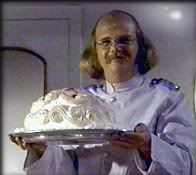 I love Wint & Kidd because they love what they do. They’re not even particularly mean about it; the pair just matter of factly take delight in offing one person after the next. I could watch an entire movie detailing the antics of Wint & Kidd; it’d be like Rosencrantz and Guildenstern are Dead only funny.
I love Wint & Kidd because they love what they do. They’re not even particularly mean about it; the pair just matter of factly take delight in offing one person after the next. I could watch an entire movie detailing the antics of Wint & Kidd; it’d be like Rosencrantz and Guildenstern are Dead only funny. Zee Villain: Only a dyed-in-the-fishnet Rocky Horror nut would choose Charles Gray as his favorite Blofeld; add in worship of The Devil Rides Out and the deal’s sealed. After the Pleasance & Savalas incarnations (as well as the “unseen” Blofeld from the earlier films), Gray’s casting seems borderline ridiculous -- the guy’s suddenly got a full head of hair and has lost any sort of imposing demeanor or freak factor. He’s this prissy dandy about to explode in a ball of flame at any second. Diamonds are his hangup, fer christsakes!!! Certainly no other Blofeld would’ve hired Wint & Kidd to do his evil bidding. Queerest of all? The baffling intimation that Miss Case shacks up with him to save her skin in the third act. Maybe he’s just keeping up appearances? Tiffany’s certainly got the style, class and wit to play fag hag should the situation demand it.
Zee Villain: Only a dyed-in-the-fishnet Rocky Horror nut would choose Charles Gray as his favorite Blofeld; add in worship of The Devil Rides Out and the deal’s sealed. After the Pleasance & Savalas incarnations (as well as the “unseen” Blofeld from the earlier films), Gray’s casting seems borderline ridiculous -- the guy’s suddenly got a full head of hair and has lost any sort of imposing demeanor or freak factor. He’s this prissy dandy about to explode in a ball of flame at any second. Diamonds are his hangup, fer christsakes!!! Certainly no other Blofeld would’ve hired Wint & Kidd to do his evil bidding. Queerest of all? The baffling intimation that Miss Case shacks up with him to save her skin in the third act. Maybe he’s just keeping up appearances? Tiffany’s certainly got the style, class and wit to play fag hag should the situation demand it.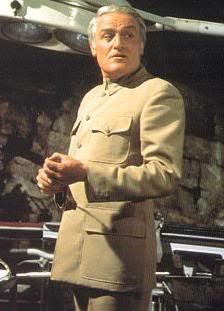 All supposition aside, fact remains it’s Charles flippin’ Gray. His Blofeld demands no exploration due to the actor alone. He stands apart from all other Blofelds, and it’s no wonder the series closed the curtain on the character after Diamonds (aside from a brief cameo in For Yours Eyes Only) -- Gray killed it for any actor who might have come afterwards. Who else can deliver--with panache--this sort of tongue-in-cheek nonsense?:
All supposition aside, fact remains it’s Charles flippin’ Gray. His Blofeld demands no exploration due to the actor alone. He stands apart from all other Blofelds, and it’s no wonder the series closed the curtain on the character after Diamonds (aside from a brief cameo in For Yours Eyes Only) -- Gray killed it for any actor who might have come afterwards. Who else can deliver--with panache--this sort of tongue-in-cheek nonsense?:
Blofeld: “The satellite is at present over…Kansas. Well, if we destroy Kansas the world may not hear about it for years.”
Tuneage & Credits Sequence: Of Bassey’s three Bond tunes, Diamonds are Forever is easily my favorite. It’s a sexy, cool number that slinks along, doing exactly what it’s supposed to do, which is set a tone for the film to come. Binder’s credits sequence also gets the job done, but ultimately feels as if it’s going through the motions: Diamonds, Blofeld’s pussy, the standard cache of scantily clad women and not much more.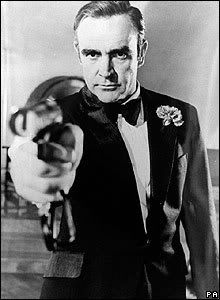 Bond, James Bond: So what of Sean Connery in his official series swansong? Assessing his performance as bored or lackluster (which is where I was inclined to head) just doesn’t seem right. It’s Sean Connery, and of the three primary Bonds, he delivers the tightest goods upon exiting the franchise. There’s certainly never the impression that he’s done all he can with the role or that it’s past time for him to go (unlike, say, Moore in A View to a Kill). And yet the franchise itself had probably done all it could with Connery.
Bond, James Bond: So what of Sean Connery in his official series swansong? Assessing his performance as bored or lackluster (which is where I was inclined to head) just doesn’t seem right. It’s Sean Connery, and of the three primary Bonds, he delivers the tightest goods upon exiting the franchise. There’s certainly never the impression that he’s done all he can with the role or that it’s past time for him to go (unlike, say, Moore in A View to a Kill). And yet the franchise itself had probably done all it could with Connery.
Diamonds are Forever is not an especially good film (by Bond standards anyway), and when compared to the Connery flicks that preceded it, it comes up laughable. When compared to the Sean-less movie that preceded it, it comes up insulting. (Do Bond flicks tend to polar react to the films that preceded them?) For all the missiles fired at the Moore era, one need look no further than Diamonds to see the campiest sides of James Bond originated here. Much of the blame can likely be laid at the feet of co-screenwriter Tom Mankiewicz, who seems the logical candidate for the camping up of Bond. He continued variations of the trend with Live and Let Die and The Man with The Golden Gun and pretty much developed the template for the Moore era. One of the dumbest trends that started on Mankiewicz’s watch is the placing of 007 into stupid, cumbersome vehicles in which he’s forced to engage in ludicrous chase scenes – here it’s a moon buggy.
But maybe, as the first Bond flick of the ‘70s, that’s how it should be. Diamonds feels transitional; maybe even like a Moore flick that Connery’s been plopped down into the middle of. Had it starred Moore, he’d have the necessary doubletakes to pull it off. With Connery, it too often seems out of time and place and it’s no wonder he didn’t return for Live and Let Die, despite being offered what at the time was considered a small fortune.
The movie was allegedly a conscious revamp of the series for the American market and as such it’s a success. If James Bond is going to do America, Las Vegas (the primary locale) is the perfect fit. The movie, like Vegas, is gawdy, over-the-top and features silly one-liners, bad puns, ridiculous chase scenes, the words “goddamn” & “bitch” and some fairly excessive violence. I remain grateful that--despite numerous considerations--the series has never cast an American as James himself...
[1] Time for a Bond talkback game! Aside from popping my Bond cherry, Diamonds are Forever also came out in December of 1971 -- when I was about a month old. This, of course, means nothing to most readers, but it means a little something to me. Most people under the age of 45 can figure out the Bond flick that was most likely in the public consciousness around the time they were born. If you were born in or around either ‘67 or ‘83 you get the added bonus of claiming two flicks. If however, like my kid, you were ushered into the world in the early ‘90s, you’re sorta screwed.

